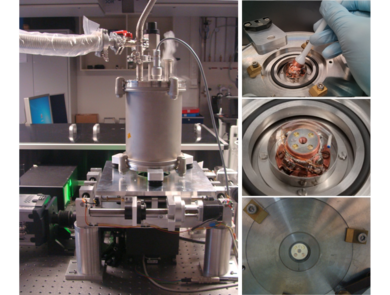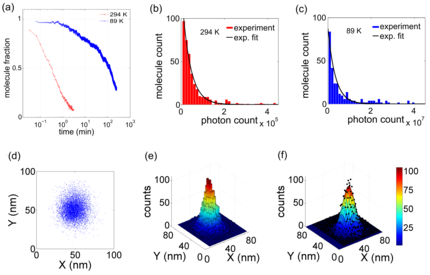Ultra-stable cryostage for cryo fluorescence microscopy applications
We present a sample holder to be used in cryo fluorescence microscopes or to simply and cost effectively upgrade a room temperature fluorescence microscope into a cryo fluorescence microscope. It has been shown that a clear correlation exists between temperature and photon yield on one side and photon yield and localization accuracy on the other side. Known problems of cryo temperature microscopes like temperature or mechanical instability are being solved by the design of the sample holder. A unique feature of the setup is the possibility to perform a sample change below the glass transition temperature of water. This makes it possible to study a vitrified sample correlatively by various techniques without destroying it through the formation of crystalline ice or ice condensation on the sample.
Challenges
2014's Nobel prize in chemistry has impressively shown that super-resolution fluorescence microscopy is an essential and increasingly important tool for studying biological systems. In fluorescence microscopy applications, biological structures are stained with fluorescent molecules and excited by laser irradiation of a particular wavelength during imaging. The colder the sample is, the longer the fluorescence molecules stay active, and, therefore, their localization accuracy increases. Controlling the thermal drifts and mechanical vibrations, both caused by the cooling system, are a major issue.
Our Solution

Picture of the sample holder (including cryostat and vacuum chamber) on its mounting stage. On the left side the optical path of the microscope is visible. The vacuum roughing hose and the nitrogen line are removed during measurement. The three magnifications on the right side show from top to bottom: Mounting of the sample holder, sample holder in place and the closed vacuum vessel with viewport. (Source: Li)
A completely redesigned sample holder with an integrated cooling unit and an integrated vibration damping system makes it possible to upgrade any room temperature fluorescence microscope into a cryo fluorescence microscope. Notable features of the setup are a localization accuracy of less than one nanometer which is below the dimensions of the commonly used fluorescence markers. Cryo temperatures of 89K can cost effectively be reached by using liquid nitrogen and the time span for sample cooling has been reduced to a few minutes when compared to commercially available systems. However, the main feature is the possibility to exchange samples below the glass transition temperature of water. This makes correlative measurements (fluorescence microscopy, SEM, X-Ray, ...) possible in the first place since it prevents the formation of crystalline ice which again would destroy the sample or form a strong background.
Advantages
- Localization accuracy below one nanometer
- Sample exchange below the glass transition temperature of water possible
- Measurements at 89K (when using liquid nitrogen)
- Photon yield per molecule is increased by two orders of magnitude compared to room temperature
- Photo stability is strongly enhanced when compared to room temperature
- Short cooling cycles (293K --> 89K) in the range of few minutes
- Portable and stand-alone operation
- Cost effective by using nitrogen as cryogenic agent
Developmental Status

(a) Photobleaching of the fluorescence molecules at room temperature (red) and at 89K (blue). At room temperature 50% of all molecules are bleached after 20 seconds while the same process takes 7600 seconds at 89K. (b) Detected photons per molecule at room temperature. (c) Emitted photons per molecule at 89K. (d) Measured position of a fluorescence molecule after drift correction. (e) Histogram of the data. (f) Gaussian fit to data (Source: Li)
The performance of all components has been tested and optimized with respect to an increased thermal and mechanical stability. In addition, the sample holder has been installed completely and is being used by the work group on a daily basis. All gained results are in agreement with previously performed simulations and calculations. In addition to the sample holder itself exists a huge amount of supplemental equipment including housings, clamps, stands, ... . Procedures for performing measurements or sample preparations have been established as well.
Applications
The sample holder is interesting for all known microscopy techniques, particularly for fluorescence microscopy purposes and of course super-resolution microscopy techniques like PALM (photoactivated localization microscopy) and STORM (stochastic optical reconstruction microscopy).
Patent Status
European patent application: EP3054338 (A1)
Patent applicant: Georg-August-Universität Göttingen Stiftung Öffentlichen Rechts
References
Ultra-stable and versatile widefield cryo-fluorescence microscope for single-molecule localization with sub-nanometer accuracy
DOI:10.1364/OE.23.003770
Weixing Li, Simon C. Stein, Ingo Gregor, and Jörg Enderlein
Optics Express, Vol. 23, Issue 3, pp. 3770-3783 (2015)
Contact
Dr. Maria Kamper
Patent Manager Physics & Technology
E-Mail: This email address is being protected from spambots. You need JavaScript enabled to view it.
Tel.: +49 (0) 551 30 724 159
Reference: MM-1784-SUG
www.sciencebridge.de
Tags: Laser physics and optics
